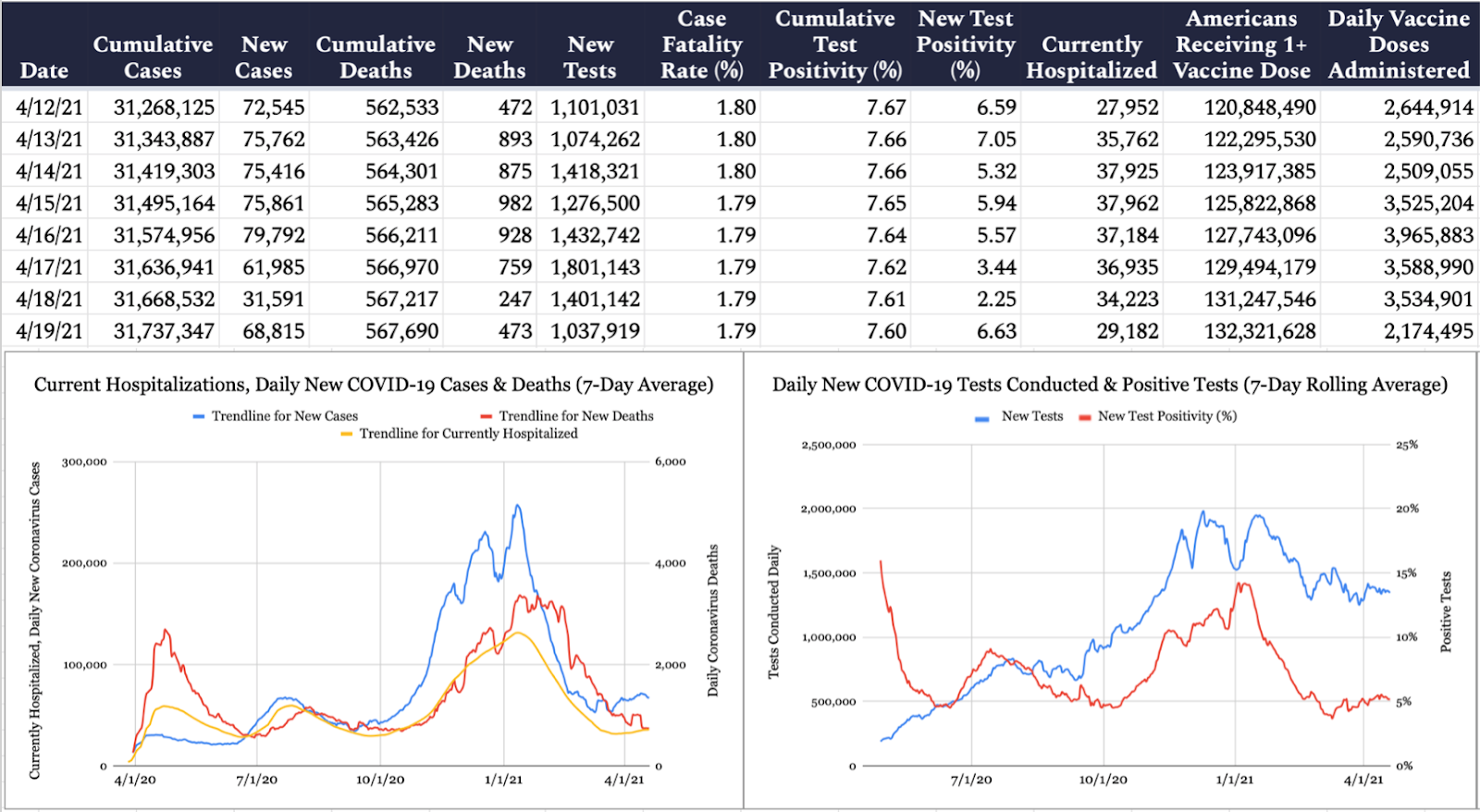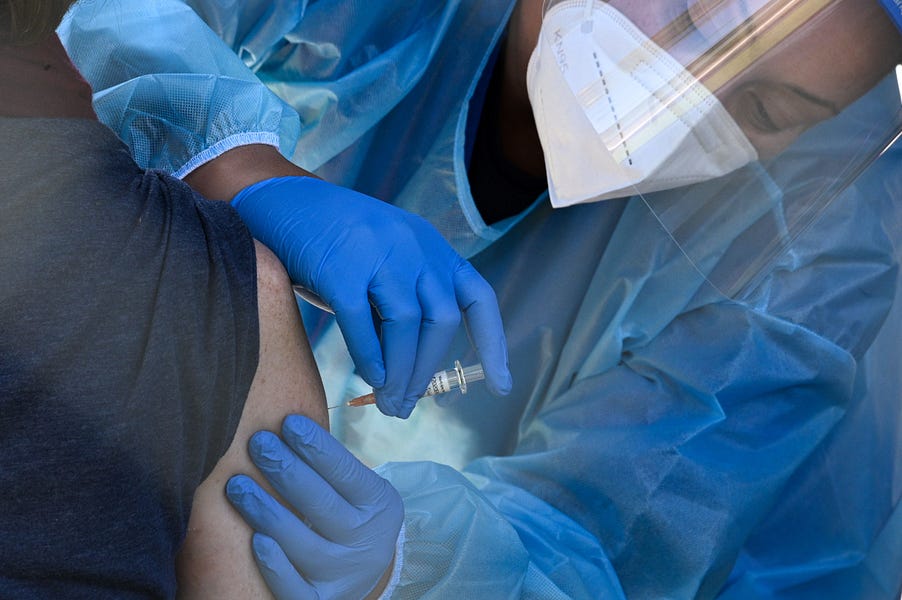Happy Tuesday! Apparently D.C. hasn’t been enforcing parking regulations all year—why didn’t anybody tell us?
Quick Hits: Today’s Top Stories
-
Russian opposition leader Alexei Navalny has been moved to a hospital in another penal colony following warnings from physicians that he could die within days if not granted immediate medical care. The transfer comes amid online organizing by Navalny’s supporters to hold large-scale protests April 21 and warnings from the international community that Russia would be held responsible for his death.
-
GOP Rep. Steve Stivers of Ohio announced he will be resigning from the House effective May 16 to become the president of Ohio’s Chamber of Commerce. The move takes Stivers out of the running for Ohio’s U.S. Senate seat, and will initiate a special election to fill the safely Republican seat.
-
The iOS app store will allow Parler to return to its platform following revisions to the social media app’s content moderation policies, according to a letter from Apple to Republican lawmakers.
-
Washington, D.C.’s chief medical examiner ruled Monday that U.S. Capitol Police officer Brian Sicknick suffered two strokes and died of natural causes on January 7—one day after he confronted rioters at the Capitol. The examiner added that “all that transpired [at the Capitol] played a role in his condition.”
-
Former Vice President Walter Mondale—who served under President Jimmy Carter from 1977 to 1981 and was the Democratic nominee for president in 1984—died yesterday at the age of 93.
-
The United States confirmed 68,815 new cases of COVID-19 yesterday per the Johns Hopkins University COVID-19 Dashboard, with 6.6 percent of the 1,037,919 tests reported coming back positive. An additional 473 deaths were attributed to the virus on Monday, bringing the pandemic’s American death toll to 567,690. According to the Centers for Disease Control, 29,182 Americans are currently hospitalized with COVID-19. Meanwhile, 2,174,495 COVID-19 vaccine doses were administered yesterday, with 132,321,628 Americans having now received at least one dose.

We’re So Close
More than a year into the COVID-19 pandemic, it seems safe to say that we’re finally—finally—approaching the endgame. As of last Sunday, more than half of all eligible U.S. adults have received at least one dose of a COVID vaccine. And on Monday, the White House announced that all 50 U.S. states have now opened vaccine availability to their full adult population.
We’re no longer at the stage where we have to worry about pharmaceutical companies churning out doses fast enough, or supply chains getting them to vaccination sites in sufficient quantities. The single thing standing between us and herd immunity is a simple matter of getting people to go down to the CVS or doctor’s office or pop-up vaccination site and roll up their sleeves.
Even this might be an easier task to accomplish than we’d initially thought. According to a survey conducted by the U.S. Census Bureau last month, vaccine hesitancy has waned considerably since the onset of the pandemic. Only 17 percent of the 80,000 adults sampled in the survey said they either “definitely” (9 percent) or “probably” (8 percent) wouldn’t get the vaccine. (That figure stood at 22 percent in January.) Not surprisingly, vaccine reluctance remains most prominent among young people: 23 percent of 18 to 39-year-olds said they were at least unlikely to get the vaccine, compared to just 7 percent of those 65 and older.
Still, really putting the pandemic six feet under will require convincing at least some of these people to soften their stance and endure the jab. “The psychologists have told us that information is fundamental, but it’s usually not sufficient to motivate behavior,” Dr. William Schaffner, an infectious disease specialist at Vanderbilt, told The Dispatch. “What you have to do is influence people’s attitude: How they feel about stuff. That information goes to the brain. Feeling messages go to the heart.”
“How comfortable are you? How reassured? What’s the social implication of your being vaccinated? Are you an outlier or is everybody doing it? Those sorts of things motivate behavior,” Schaffner added. “And so we have to not only provide clear, transparent, honest information. We have to provide a sense of reassurance and a sense of comfort that this is really a good thing for themselves, their families, and communities.”
As we approach summer, we will likely begin to see large disparities in transmission rates both across state lines and on the county level. “What I do see is a patchwork quilt,” Schaffner said. “Some areas really well vaccinated, bending the curve [and] really reducing the transmission of the virus. Other parts—maybe only a few miles away—you’ll have a county where vaccination rates are very low and the virus keeps smoldering along and making people sick.”
He spoke of his home state of Tennessee, where vaccine uptake varies widely from town to town. “The difference between the cities and the rural areas is very stark,” Schaffner said. “The vaccine is really not much embraced yet in the rural areas and we have vaccine and health department refrigerators yearning to be used but the appointments are going unfilled.”
This difference is compounded by the fact that, for some, COVID vaccines have been swept up in the political churn of the constant culture war, such that vaccine hesitancy remains significantly higher among right-wing people than among left-wing ones.
“It’s a tough problem, because in many ways it’s connected to, you know, political identities,” said Jeff Niederdeppe, an expert in public health messaging at Cornell. “That kind of strategy means you really need people within your tribe to be making the case for it.”
“When I say in your tribe, that’s obviously been part of the goal of having ex-presidents Bush and Clinton and all these folks say ‘I’m getting a vaccine,’” Niederdeppe continued. “But there’s still a sort of outside-the-majority segment of the political right in some parts of the country that are very anti-establishment politician. … So I do think you need some of those people who are credible in those communities to come out, and it’s a really hard thing to do—in part because they’re some of the messengers that are driving this skepticism.”
One thing may help in the weeks ahead: The example of other countries whose vaccine efforts have allowed them to return to near-normalcy. Very few countries have done as well as the U.S. in vaccinating their populations so far, but an exception is Israel, which has fully vaccinated roughly 56 percent of its approximately 9 million citizens. As a result, the country’s number of positive cases—as well as COVID-related deaths and hospitalizations—have fallen precipitously: Israel is now averaging about 160 new cases per day (down from 8,620 in January), and less than six deaths attributed to the virus per day (down from 65 per day in January).

The successful vaccine rollout has prompted the Israeli government to lift most of its pandemic related restrictions. All primary and secondary schools are now open for in-person instruction, mask-wearing is no longer required outdoors, and the country will be open to vaccinated tourists beginning next month. To access other, riskier activities—indoor dining, some religious services, concerts, gyms, sporting events, etc.—fully vaccinated Israelis are required to flash a digital vaccination certificate (or “Green Pass”) for entry.
Nachman Ash, the country’s vaccine czar, said last week that “if there is no rise in contagion, everything will be open in a month.”
Flight on Mars
Nearly 120 years after the Wright Brothers first tasted the skies in Kitty Hawk, North Carolina, NASA replicated their accomplishment—on another planet. At 12:33 Local Mean Solar Time (Mars time) on Monday, the Ingenuity Mars Helicopter hovered 10 feet over the surface of the Red Planet for 39.1 seconds. It was the first ever powered, controlled flight on another planet (that we know of!).
“Ingenuity is the latest in a long and storied tradition of NASA projects achieving a space exploration goal once thought impossible,” acting NASA Administrator Steve Jurczyk said Monday. “We don’t know exactly where Ingenuity will lead us, but today’s results indicate the sky—at least on Mars—may not be the limit.”
George Tahu, the Mars 2020 Perseverance program executive at NASA, told The Dispatch he and the team were “ecstatic” and “relieved” with the flight. “As far as we could tell, everything worked exactly as planned,” he said.
The success of the mission was far from guaranteed. With just a third of the gravitational pull and 1 percent of the air pressure, Mars’ atmosphere is far less suitable for aerial flight than Earth’s. Tahu compared it to flying a plane 100,000 feet above the Earth’s surface, about three times the altitude of a typical commercial flight. Located 173 million miles from NASA’s Jet Propulsion Lab (JPL) in Pasadena, California, the four-pound Ingenuity helicopter’s flight couldn’t be controlled from Earth, either: Once its latest programming was uploaded, the robot was essentially on its own.
But the little craft overcame the odds and will now move forward with a series of missions aimed at testing the effectiveness of aerial exploration of Mars. It’s now just over halfway through its 31-day flight test window. “We really have a lot lined up,” Tahu said. “This is the month of Ingenuity—and it’s not just the helicopter.”
In the next few days, NASA hopes to test another piece of technology—the Mars Oxygen In-Situ Resource Utilization Experiment (MOXIE)—which, if successful, will be able to convert the carbon dioxide in Mars’ atmosphere into oxygen and carbon monoxide. Such a capability would be vital for any future manned missions to the planet—not just for breathing, but for rocket propulsion to eventually leave the planet.
“This is a way of seeing, ‘Hey, can we learn to live off the land, so to speak, for when we eventually send humans?’” Tahu said. “We can use the resources right there on Mars, pulling it out of the air to generate oxygen. … In the late 2030s, you could envision potentially sending humans.”
The Ingenuity Mars Helicopter first touched down on the Red Planet on February 18, attached to the “belly” of the Perseverance Mars Rover, which quickly got to work driving around and testing samples from Mars’ surface in its quest to discover signs of ancient microbial life.
“There’s no such thing as a Star Trek tricorder to take on your Rover to say ‘Hey, yeah, that’s life,’” Tahu said. “You really have to bring [samples] back, analyze them here with all the capabilities we have on Earth, to potentially answer that question: Are we alone?”
Worth Your Time
-
Are we living in a post-outdoor masking world? Derek Thompson thinks so, and he outlines several compelling arguments as to why in his latest for The Atlantic. Face coverings are highly effective at slowing indoor transmission of COVID-19, but “as more and more of the population is vaccinated, governments need to give Americans an off-ramp to the post-pandemic world,” he writes. “Ending outdoor mask mandates—or at the very least telling people when they can expect outdoor mask mandates to lift—is a good place to start.” With few known instances of outdoor transmission, sweeping mask requirements only serve to undercut the authority of public health officials and bolster the case of mask and vaccine skeptics. “Getting beyond the pandemic in the U.S. will require a portfolio approach that combines hard science with soft persuasion.”
-
As easy as it is to rag on professional athletes for going through slumps or failing to live up to expectations, it’s important to remember that even the worst player in a professional league is considerably better than even the best amateur. In a fun piece for the New York Times, basketball writer Sopan Deb talked to a handful of NBA and WNBA players who have been challenged to random one-on-one games, and explored how those games typically go. Michael Sweetney, a role player for the New York Knicks from 2003 to 2007, recently beat a handful of challengers 11-1 and 11-2. “It was another reminder: When a player makes the NBA, no matter for how long, he is, in that moment, one of the 500 best basketball players in the world,” Deb writes. Brian Scalabrine, a longtime benchwarmer for the Boston Celtics and Chicago Bulls, said his onetime teammate Joakim Noah best described the phenomenon. “He said, ‘Scal, you look like you suck, but you don’t suck.’”
-
With the news of Walter Mondale’s passing, here’s a video clip from 1981 showing a different era of American politics: Mondale, as vice president, certifying his own resounding electoral defeat to a bipartisan standing ovation. (We tried to isolate the clip in the link above, but in case it’s not working for you: Click here, and fast forward to 31:45.)
Presented Without Comment
Toeing the Company Line
-
On yesterday’s episode of Advisory Opinions, Sarah and David discussed Monday’s Supreme Court orders and oral arguments before diving into the listener mailbag to answer questions about expert witnesses, sanctuary cities, vaccine passports, and immunity grants.
Let Us Know
How many years of your childhood did you spend wanting to be an astronaut? (If not an astronaut, what was your childhood dream job?)
Reporting by Declan Garvey (@declanpgarvey), Andrew Egger (@EggerDC), Haley Byrd Wilt (@byrdinator), Audrey Fahlberg (@FahlOutBerg), Charlotte Lawson (@charlotteUVA), Ryan Brown (@RyanP_Brown), and Steve Hayes (@stephenfhayes).






Please note that we at The Dispatch hold ourselves, our work, and our commenters to a higher standard than other places on the internet. We welcome comments that foster genuine debate or discussion—including comments critical of us or our work—but responses that include ad hominem attacks on fellow Dispatch members or are intended to stoke fear and anger may be moderated.
You are currently using a limited time guest pass and do not have access to commenting. Consider subscribing to join the conversation.
With your membership, you only have the ability to comment on The Morning Dispatch articles. Consider upgrading to join the conversation everywhere.